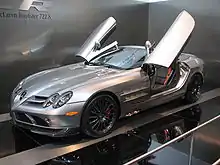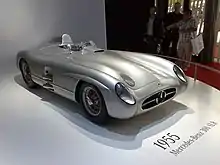 Mercedes-Benz 300 SLR preserved at the Mercedes-Benz Museum | |
| Category | World Sportscar Championship |
|---|---|
| Constructor | Daimler-Benz AG |
| Designer(s) | Rudolf Uhlenhaut |
| Technical specifications | |
| Suspension (front) | Double wishbone, torsion bar springs, telescopic shock absorbers |
| Suspension (rear) | Single-joint swing axle, longitudinal torsion-bar springs, telescopic shock absorbers |
| Engine | Mercedes-Benz M 196 S 2,982 cc (182 cu in) straight-8 naturally aspirated front-mid |
| Transmission | Daimler-Benz 5-speed transaxle gearbox |
| Fuel | Super petrol (98 RON) |
| Tyres | Continental |
| Competition history | |
| Notable entrants | Mercedes |
| Notable drivers | |
| Debut | 1955 Mille Miglia |
The Mercedes-Benz 300 SLR (W 196 S) is a two-seat sports racing car that took part in the 1955 World Sportscar Championship before a catastrophic crash and fire at Le Mans later that year ended its domination prematurely. The car was designated "SL-R" (for Sport, Leicht, Rennen, eng: sport, light, racing version), which was later condensed to "SLR". Technically, the W 196 S is based on the W 196 R, but has a slightly different engine, displacing 3 litres.
Just as the W 196 R Formula One racer's M 196 R engine, the 300 SLR's M 196 S engine is a direct-injected 3-litre straight-eight engine (but with a 78 mm bore and stroke); its rated power is 302 PS (222 kW).[1]
The W 196 S's monoposto driving position was modified to standard two-abreast seating, headlights were added, and a few other changes made to adapt a strictly track competitor to a 24-hour road/track sports racer.
Hall of Fame Formula One driver and former Mercedes-Benz team 300 SLR race driver Stirling Moss described the 300 SLR as "The greatest sports racing car ever built – really an unbelievable machine."[2]
Two of the nine 300 SLR rolling chassis produced (nicknamed the "Uhlenhaut Coupé") were converted into 300 SLR/300 SL hybrids. Effectively road legal racers, they had coupé styling, gull-wing doors, and a footprint midway between the two models.
When Mercedes-Benz cancelled its racing programme after the Le Mans disaster, the hybrid project was shelved. Company design chief Rudolf Uhlenhaut, architect of both the 300 SLR racer and the hybrids, appropriated one of the leftover mules as his personal car. Capable of approaching 290 km/h (180 mph), the Uhlenhaut Coupé was by far the fastest road car in the world in its day.
A 1955 Mercedes-Benz 300 SLR Uhlenhaut Coupé has become the most expensive car to ever be sold after being auctioned off for €135 million. The car, previously owned by Mercedes-Benz, was sold by RM Sotheby’s to an unknown collector at the Mercedes-Benz Museum on 5 May 2022.[3]
History
Name
In spite of its name and strong resemblance to both the streamlined 1952 W194 Le Mans racer, and the iconic 1954 300SL Gullwing road car it spawned, 1955 300 SLR was not derived from either. Instead, it was based on the wildly successful 2.5-litre straight-eight-powered 1954–1955 Mercedes-Benz W196 Formula One champion, with the engine, enlarged to 3.0 litres for the sports car racing circuit and designated "SL-R" for Sport Leicht-Rennen (eng: Sport Light-Racing). All were the work of Daimler-Benz's design chief Rudolf Uhlenhaut.
Racing record
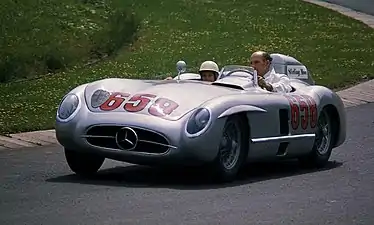
Mercedes team driver Stirling Moss won the 1955 Mille Miglia in a 300 SLR, setting the event record at an average of 157.650 km/h (97.96 mph) over 1,600 km (990 mi). He was assisted by co-driver Denis Jenkinson, a British motor-racing journalist, who informed him with previously taken notes, ancestors to the pacenotes used in modern rallying. Teammate Juan Manuel Fangio was second in a sister car.
After missing the first two races at Buenos Aires in Argentina and the 12 Hours of Sebring in the United States, where Ferrari scored a victory and a second place respectively, the 300 SLRs later scored a decisive 1-2-3 finish in the Tourist Trophy at Dundrod, Ireland, and a 1-2 at the Targa Florio in Sicily, earning Mercedes victory in the 1955 World Sportscar Championship, two points ahead of Ferrari. Further non-championship trophies were also scored at the Eifelrennen in Germany and the Swedish Grand Prix.[4]
Of the six races entered, the 300 SLR won five and was withdrawn from one:[5] the car's impressive record was overshadowed at Le Mans, when the once again leading 300 SLRs were withdrawn after a horrific accident involving a team car driven by Pierre Levegh. Even with the innovative wind-brake, the car's drum brakes could not help prevent Levegh from rear-ending an Austin-Healey coming into his way, launching his car into the air. Upon impact, the ultra-lightweight Elektron bodywork's high magnesium content caused it to ignite and burn in the ensuing fuel fire. Compounding it, an uninformed race fire crew initially tried to extinguish the fire with water, only making it burn hotter. Eighty-three spectators and Levegh lost their lives in what remains the highest-fatality accident in the history of motorsport. Mercedes terminated its motorsport programme at the end of the 1955 season and would stay away from racing for the next three decades.
Uhlenhaut Coupé
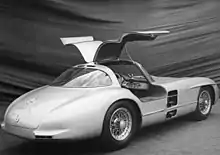
Daimler-Benz made two road-legal 300 SLR coupés, known today as Uhlenhaut Coupé. One of these two cars once served as the personal car of its designer, Daimler-Benz motorsport chief Rudolf Uhlenhaut, hence the name.
Prior to the Le Mans accident he had ordered two of the nine W196 chassis built to be set aside for modification into an SLR/SL hybrid. The resulting coupé featured a significantly more sculpted body than the 300 SL fitted over a slightly widened version of the SLR's chassis, with signature 'gull-wing' doors still needed to clear its spaceframe's high sill beams. These were intended to race in the Carrera Panamericana which was cancelled because of safety concerns following the Le Mans disaster.
Before the project could be seen through, however, Mercedes announced a planned withdrawal from competitive motorsport at the end of 1955, in the works even before Le Mans. The hybrid program was abandoned, leaving Uhlenhaut to appropriate one of the leftover mules as a company car with only a large suitcase-sized muffler added to dampen its near-unsilenced exhaust pipes.
With a maximum speed approaching 290 km/h (180 mph),[4] the 300 SLR Uhlenhaut Coupé easily earned the reputation of being the era's fastest road car. A story circulates that, running late for a meeting, Uhlenhaut roared up the autobahn from Munich to Stuttgart in just over an hour, a 220-kilometre (137 mi) journey that today takes two-and-a-half hours.[6]
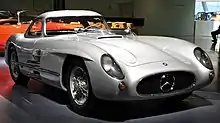
US auto enthusiast magazine Motor Trend road tested the car, as did two English journalists from Automobile Revue, who spent more than 2,000 miles (3,200 km) behind its wheel. After a high-speed session at four o'clock in the morning on an empty section of autobahn outside Munich the latter wrote: "We are driving a car which barely takes a second to overtake the rest of the traffic and for which 120 mph on a quiet motorway is little more than walking pace. With its unflappable handling through corners, it treats the laws of centrifugal force with apparent disdain."[7]
Their only regret was that "we will never be able to buy [the car], which the average driver would never buy anyway.".[7]
One Uhlenhaut Coupé has been preserved by Mercedes-Benz and is displayed at its corporate museum in Bad Cannstatt. Its only sibling was sold from the museum in May 2022 to a private collector for 141 million EUR (138 million GBP or 142 million USD) with the proceeds used to establish the Mercedes-Benz Fund. The price was the highest ever paid for a car, either at private sale or public auction, surpassing the previous record of 75 million USD (69 million EUR) for a Ferrari 250 GTO.[8][9]
Technical description
Design
The 300 SLR was front mid-engined, with its long longitudinally-mounted engine placed just behind the front axle to better balance front/rear weight distribution. A brazed steel tube spaceframe chassis carried ultra-light Elektron magnesium-alloy bodywork (having a relative density of 1.8, less than a quarter of iron's 7.8), which contributed substantially to the low vehicle mass of 901 kg (1,986 lb) for the roadster,[10] 1,117 kg (2,463 lb) in the case of the coupé.[11]
The SLR had a second seat for a co-driver, mechanic, or navigator, depending on the race. As it turned out, this was only needed during the Mille Miglia, as the 1955 Carrera Panamericana was cancelled due to the 1955 Le Mans accident. On some circuits such as the Targa Florio the extra seat was covered and passenger windshield removed to improve aerodynamics. The front windshield for the two-seater mode was originally steeply raked, but due to intense turbulence in the cabin this was redesigned repeatedly during testing at Hockenheim before Mille Miglia. Jenkinson used the long curls of his trademark beard as flow visualization aids. Thus evaluated, the final design used at Mille Miglia ended up being near vertical.[12]
A total of nine W 196 S chassis were built: seven roadsters, and two coupés. Work was ongoing on an updated design for 1956 when Mercedes-Benz abruptly announced their withdrawal from all forms of motorsport following the Le Mans tragedy. The front suspension, the engine, and the brakes were being redesigned for this cancelled project; in parallel with the Uhlenhaut Coupés a coupé version had also been under development, with the aim of once again winning the Carrera Panamericana.[5]
Engine
The M 196 S engine is a naturally aspirated straight-eight engine with a bore and stroke of 78.0 mm (3 in), resulting in a displacement of 2,982 cc (182 cu in). The engine has a peak power output of 310 PS (228 kW) at 7400 rpm, with maximum sustained power of 276 PS (203 kW) at 7000 rpm.[11] Its maximum torque is 31.7 kp⋅m (311 N⋅m) at 5950 rpm, giving the engine a very high BMEP of 1.31 MPa (190 lbf/in2). Like in the W 196 R, the engine was canted to the right at 53 degrees to lower the car's profile, resulting in slicker aerodynamics and a distinctive bulge on the passenger side of the hood shared with the streamlined Type Monza Formula one car. To reduce crankshaft torsion, power takeoff was from the centre of the engine via a gear rather than at the end of the crankshaft. Daimler-Benz fitted the engine with a single desmodromic intake valve, and a single desmodromic exhaust valve per cylinder, actuated by two spur-gear driven overhead camshafts. The fuel system is a direct fuel injection system with a mechanically driven eight-plunger inline injection pump made by Bosch. In addition to that, the W 196 S's engine was fitted with a dry-sump lubrication system and chromium-coated aluminium cylinder sleeves. For ignition, the engine was equipped with conventional double magnetos.[11] Unlike the M 196 R engine, the M 196 S engine is designed to run on standardised, commercially available Super 98 RON petrol (DIN 51600).[1]
Suspension system
To enhance stopping power extra wide diameter drum brakes too large to fit inside 16" wheel rims were used, mounted inboard with short half shafts and two universal joints per wheel. Suspension was four-wheel independent. Torsion bars fitted inside the frame's tubes were used in the double wishbone front. To prevent cornering forces from raising the car, as occurs with short swing axles, the rear used a low-roll centre system featuring off-centred beams spanning from each hub to the opposite side of the chassis crossing one-another over the centreline. Nevertheless, snap-oversteer could be still a notable problem at speed.
At Le Mans in 1955, the 300 SLRs were also equipped with a large rear mounted "wind brake" that hinged up above the rear deck to slow the cars at the end of the fast straights. The idea came from director of motorsports Alfred Neubauer, who had been seeking to reduce wear on the huge drum brakes and tyres during long-distance endurance races where cars repeatedly had to decelerate from 180 mph (290 km/h) to as little as 25 mph.[7] In tests the 0.7 m2 (7.5 sq ft) light-alloy spoiler slowed the car dramatically and improved cornering, helping to compensate for the superior new disc brakes of the SLR's main rival Jaguar D-type.
SLR McLaren
Inspired by the 300 SLR Uhlenhaut Coupé, the Mercedes-Benz SLR McLaren grand tourer made its debut in 2003. Jointly developed by Mercedes-Benz and McLaren Automotive it featured a hand-built 5.4-litre, supercharged 626 PS (460 kW; 617 hp) all-aluminium V8 engine.
The SLR McLaren was available in both coupé and roadster versions, as well as a number of other specialized variants. Production ran through early 2010.
See also
References
Notes
- 1 2 "Mercedes-Benz Rennsportwagen 300 SLR (W 196 S), 1955: Fahrzeugtext". Classic M@RS (in German). Daimler AG. Archived from the original on 3 February 2023.
- ↑ "Sir Stirling Moss’s legendary 1955 Mille Miglia Mercedes takes one final drive", Hagerty.com, October 2021
- ↑ "1955 Mercedes-Benz 300 SLR sells for world-record £114million". Auto Express. Retrieved 16 November 2022.
- 1 2 D., Nick (18 April 2016). "1955 Mercedes-Benz 300 SLR Uhlenhaut Coupe". Supercars.net. Retrieved 2 February 2021.
- 1 2 Lainé, Didier, ed. (October 2008). "L'arme fatale" [Lethal Weapon]. Rétroviseur (in French). No. 238. Fontainebleau, France: Éditions LVA. p. 77. ISSN 0992-5007.
- ↑ Robinson, Matt (2014). "Throwback Thursday: Mercedes 300SLR 'Uhlenhaut' Coupe". Car Throttle. Retrieved 2 February 2021.
- 1 2 3 "The SLR Phenomenon – Past and Future". worldcarfans.com. 25 October 2004. p. 2. Archived from the original on 22 April 2009.
- ↑ Valdes-Dapena, Peter (19 May 2022). "Mercedes just sold the world's most expensive car for $142 million". CNN. Retrieved 19 May 2022.
- ↑ Lee, Jonathan (23 May 2022). "1955 Mercedes-Benz 300SLR Uhlenhaut Coupé most expensive car sold – one of only 2, priced at RM627mil". Paultan.org. Driven Communications Sdn Bhd.
- ↑ Daimler AG (ed.): Mercedes-Benz Rennsportwagen 300 SLR (W 196 S), 1955 – Technsiche Daten, retrieved 26 November 2021, (in German)
- 1 2 3 Daimler AG (ed.): Mercedes-Benz Rennsportprototyp 300 SLR – Technische Daten, retrieved 26 November 2021, (in German)
- ↑ Lainé (2008), pp. 74–75.
Bibliography
- Clarke, R.M., ed. (1989). Mercedes 190 & 300 SL 1954-63. Road Test Portfolio Series. Cobham, Surrey, UK: Brooklands Books. ISBN 1870642260. (includes the 300 SLR)
- Engelen, Günter (2015). Mercedes-Benz 300 SLR. Milestones of Motor Sports, Vol. 1. Ostfildern, Germany: Hatje Cantz. ISBN 9783775740012. (in English)
- Ludvigsen, Karl (2004). Mercedes-Benz 300SLR: The Fabulous 1955 World-Championship Sports-Racer. Ludvigsen Library Series. Hudson, WI, USA: Iconografix. ISBN 1583881220.
- Scheller, Wolfgang; Pollak, Thomas (2015). Rudolf Uhlenhaut: Engineer and Gentleman. The Father of the Mercedes 300 SL. Translated by Pollak, Carmen. Deerfield, IL, USA: Dalton Watson Fine Books. ISBN 9781854432827.
- Sugahara, Louis (2004). Mercedes-Benz Grand Prix Race Cars 1934–1955. Fredericksburg, TX, USA: Mercedes-Benz Classique Car Library. ISBN 1933123001. (includes the 300 SLR)
- Wirth, Thomas (2012). Mercedes-Benz Supercars: From 1901 to Today. Atglen, PA, USA: Schiffer Publishing. ISBN 9780764340901.
External links
 Media related to Mercedes-Benz 300 SLR at Wikimedia Commons
Media related to Mercedes-Benz 300 SLR at Wikimedia Commons- 1955 World Sportscar Championship
